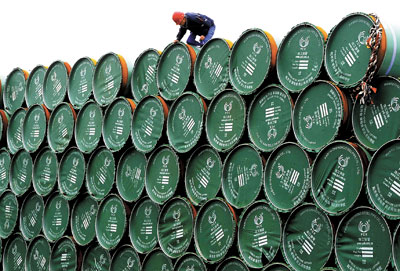|

ANNUAL growth in China’s exports and imports slowed in October, data showed Saturday, reinforcing signs of fragility in the world’s second-largest economy that could prompt policymakers to roll out more stimulus measures.
Exports have been the lone bright spot in the last few months, perhaps helping to offset soft domestic demand, but there are doubts about the accuracy of the official numbers amid signs of a resurgence of speculative currency flows through inflated trade receipts.
Exports rose 11.6 percent in October from a year earlier, slowing from a 15.3 percent jump in September, the General Administration of Customs said.
A decline in China’s leading index on exports in October pointed to weaker export growth in the next two to three months, the administration said.
“The economy still faces relatively big downward pressure as exports face uncertainties while weak imports indicate sluggish domestic demand,” said Nie Wen, an economist at Hwabao Trust in Shanghai.
“The central bank may continue to ease policy in a targeted way.”
Imports rose an annual 4.6 percent in October, pulling back from a 7 percent rise in September, and were weaker than expected. That left the country with a trade surplus of US$45.4 billion for the month, which was near record highs.
Annual growth slowed to 7.3 percent in the third quarter — the weakest since the height of the global financial crisis — as a cooling property sector weighs on domestic demand.
Recent purchasing managers’ surveys on factory and services showed the economy lost further momentum heading into the fourth quarter as the property market weighed and export demand softened, putting China’s official growth target for the year at even greater risk.
September’s surprisingly strong export growth led some analysts to question the accuracy of the official data amid signs of hot money inflows as firms tried to evade capital controls by over-invoicing precious metal sales.
The latest trade data indicated a cooldown in such speculative activity amid fears of an official crackdown.
“It’s impossible to control hot money flows. Hot money may distort trade data but it won’t affect the trend,” said Li Huiyong, an economist at Shenyin & Wanguo Securities in Shanghai.
Customs data showed China’s exports of precious metals and jewelry rose 187 percent in October from a year earlier. The pace eased from a 678 percent jump in September.
The Chinese mainland’s exports to Hong Kong, where over-invoicing is typically most pronounced, rose 24 percent in October from a year earlier, slowing from September’s 34 percent increase.
Exports to the United States, China’s top export destination, rose 10.9 percent in October from a year earlier, largely matching September’s rise, while exports to the European Union, the second-biggest market, grew 4.1 percent, slowing sharply from a 14.9 percent jump in September.
China’s external trade environment may slightly improve in 2015 but still faced uncertainties, the Ministry of Commerce said in a report published Saturday.
“It’s difficult for external demand to show a significant rebound,” the ministry said.
China’s combined exports and imports rose 3.8 percent in the first 10 months from a year earlier, the administration said. That suggests China will miss its trade growth target for a third consecutive year.
The government missed its economic growth targets of 8 percent in 2013 and 10 percent in 2012 and aims for 7.5 percent growth this year.
A deluge of China data over the coming week, including factory output and investment, is likely to show a persistent cooling in the economy, reinforcing views that authorities may need to do more to fight slackening growth.
China’s reform-minded leaders have refrained from acting forcefully, such as by cutting interest rates. That has caused concerns among some analysts that the modest policy measures may not be enough to prevent a sharper slowdown.(SD-Agencies)
|

